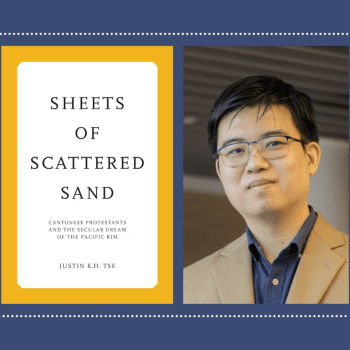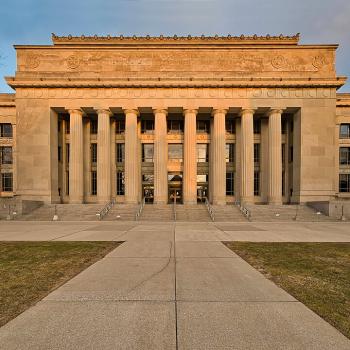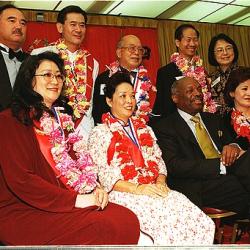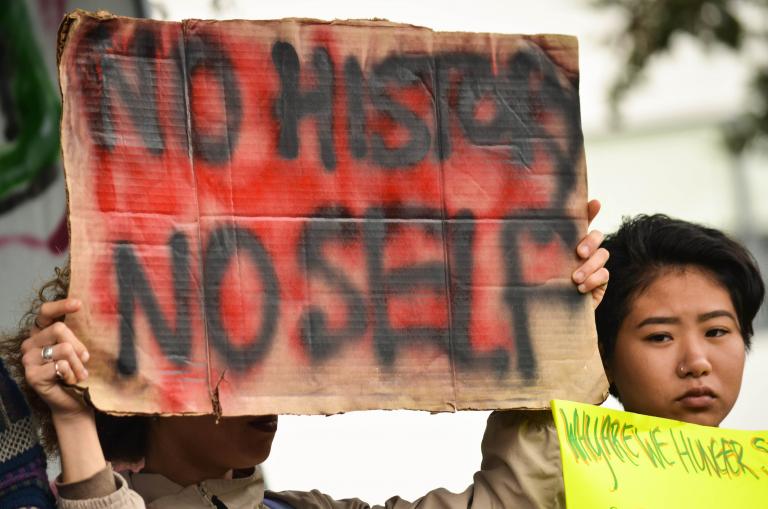
Last month marked the fiftieth anniversary of the end of the four-month, student-led strike at San Francisco State University. This strike–along with a similar protest at the University of California, Berkeley, that began in early 1969—captured national attention as student activists from the Black Student Union and the Third World Liberation Front occupied buildings and organized sit-ins and other demonstrations. Hundreds of students were arrested, and clashes with police were violent.
African American, Native American, Asian American, and Latina/o activists united to organize this strike in order to advance a radically new vision of education. Opposing the racism and colonialism that they considered to be a shared source of oppression, student strikers called for equal access to higher education and increased hiring of faculty of color. In addition, they demanded that universities change their curricula and programming to reflect and honor the experiences of all people, including racial and ethnic minorities. As a result of the strike, San Francisco State established the College of Ethnic Studies—the first college of its kind—and other universities across the United States followed suit and created their own ethnic studies programs and departments.
A half century later, students, faculty, and community activists have been reflecting on the San Francisco State strike and the past, present, and future of ethnic studies. How has ethnic studies changed how we study, understand, and teach about the United States? As a religion scholar, I’ve been particularly interested in thinking about the relationship between ethnic studies and religious studies. How has ethnic studies enriched, and also complicated, the study of American religion? And what are the challenges of working at the intersection of religious and ethnic studies?
To explore this question, I turned to four rising stars in the field of American religion:
- Dr. Jamil Drake, a specialist in African American religion and Assistant Professor in the Department of Religion at Florida State University
- Dr. Tiffany Hale, a specialist in Native American religion and Assistant Professor in the Department of Religion at Barnard College
- Dr. Justin Tse, a specialist in Asian American religion and Visiting Assistant Professor in the Asian American Studies Program at Northwestern University
- Dr. Daisy Vargas, a specialist in Latina/o religion and Assistant Professor in the Department of Religious Studies and Classics at the University of Arizona
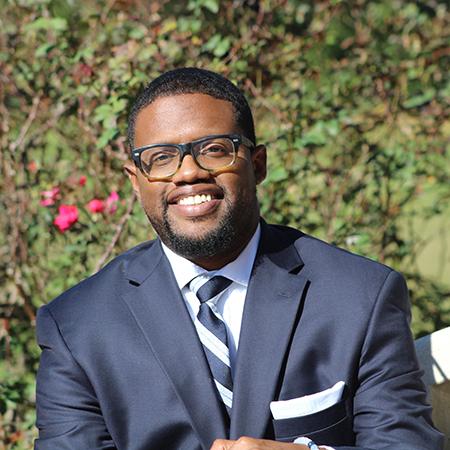
Dr. Jamil Drake: “Religion is a racial category”
“When I teach race and religion in the U.S., I like to begin the semester with a provocation that religion is a racial category. Although I get a lot of push back from students, my aim is to reorient them away from standard views of religion that are often confined to what people do in a setting they deem sacred. Rather, I want them to see how religion has had a hand in classifying and organizing racial identity and difference within specific arrangements of power and dominance. I think studying American Religion from the perspective of race shows us how religion and race are mutually constitutive. One cannot study religion apart from race in American history and culture.
African-American religion has demonstrated that race is at the heart of American religion, like gender, sexuality, class, and nationality. Scholars of African-American religion have challenged scholars of American Religion to be intentional about identifying the racial particularity of the groups under investigation. Anthropologist Marla Fredericks said it best when she noted, ‘Too often white religious practice by default has been categorized as American religion, while the study of African American religious practitioners sits solely under the category black religious studies.’ The failure to identify the racial particularly only reifies whiteness as a normative category that has been part of the study and making of ‘American Religion.’
I also think African-American religion shows how race and ethnicity are entangled. Both Judith Weisenfeld and Sylvester Johnson’s work on religio-racial movements of the early 20th century underscored how groups sought to reimagine their identities by redrawing their ancestral lineages and nationalities over and against state (and/or scientific) racial categories. Or, it always amazes me when I revisit Robert Orsi’s The Madonna of 115th Street how American white Catholics could denigrate Italian Catholics by associating their religious practices with certain African and racial characteristics and/or ‘traits.’
Scholars of black religion are beginning to think about their discipline in light of the history of black studies in general. On some level, I think historian Albert Raboteau’s Slave Religion was partly a response to certain ideas of the political that gave rise to black studies in the late 20th century. Yet, I think religious studies could offer black studies different ways of accounting for the religious, especially for blacks who are usually deemed nonreligious in the conventional sense. We see examples of the value of religious studies to black studies in the work of Josef Sorett who has shown how black aestheticians relied on the religious grammars to articulate a distinct black aesthetic. I think black studies, in particular, helps religious scholars frame religious primary sources in creative and novel ways. More specifically, I think black studies, particularly African-American history, also challenges African-American religious scholars to pay closer attention to the material conditions (e.g. labor, economy, and law) of race and culture within specific social context(s).
Looking forward, I hope for the continuation of more collaborative work and discussion among scholars of black/ethnic studies and black religion. This is already taking place at academic conferences, in departments, and collaborative scholarship. I’m looking forward to a panel for 2019 AAR panel that will directly confront this issue on the divide between history of black religious and black studies. And since black historical actors were not thinking of their religious and political struggles in isolation from other racial groups in and outside North America, we can also do more to highlight these relationships and networks.
The dilemma is challenging understandings and depictions that reduce African-American religion to sidebar conversations marginal to American religion. Black religion, in its myriad of forms, is at the center of American religion. Many scholars are studying black religion to account for larger topics and histories germane to American religion, such as secularism and colonialism; domestic surveillance and foreign diplomacy; media and technology; psychiatry and medicine; and sex crime statues and welfare programs.”
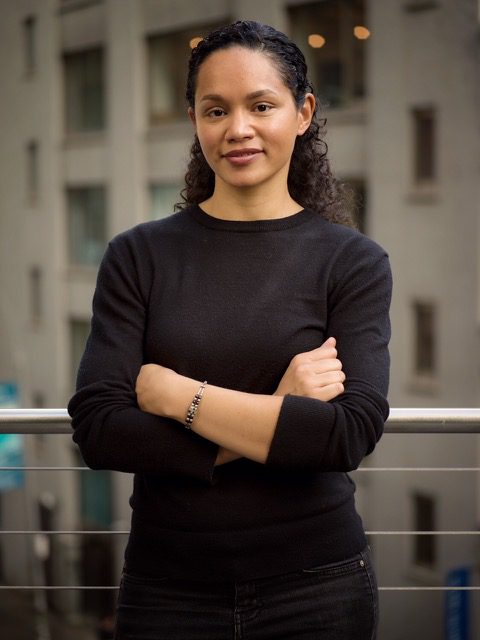
Dr. Tiffany Hale: “Native American studies is absolutely crucial because it can help to broaden people’s understanding of ‘religion’ itself”
“I think that Native American studies is absolutely crucial because it can help to broaden people’s understanding of ‘religion’ itself. What is religion? Is it church on Sunday? Is it lived experience? It sounds like a really simple question, but a lot of the theories and definitions of religion that come down to us from earlier generations of European and Euro-American scholars have to change when confronted with the experiences of indigenous peoples and the insights generated from ethnic studies.
Nomads, natives, peasants, hill people, aboriginals, hunter-gatherers, First Nations–these are just a handful of the terms in use to define indigenous peoples globally. The names these groups use to describe themselves, as well as the varying religious practices, attitudes, and beliefs among these populations are far more numerous and complex. For much of recorded history, however, colonial centers of power have defined indigenous peoples racially and often interns of lacking religion; as pagan, barbarian, non-modern, and without history or civilization. Despite this conundrum of identity and classification, indigenous and Native American religious traditions often have well-documented and observable past and present realities. The study of Native religious histories can help to illuminate the changing social, political, and legal dimensions of religious practice among Native groups over time and in relationship to the state power. Ultimately, I think Native American studies opens up new avenues for understanding the changing social, political, legal dimensions of religious practice, especially in relation to different forms of state power.
For a lot of native people, there’s distrust around talking about religion because many aspects of native religious traditions have been exploited by anthropologists and pop culture. Native people often have a real and valid reluctance to share about their traditions, and there is also the fact that in many native languages, there is no direct translation for the word religion. (That goes back to the issue of categories and the question of what is religion.) There is also such an exhaustion out there with stereotypes that native people don’t want to be associated with.
Native people have lost so much because of colonization. But the study of religion can offer an ethical approach for dealing with these complicated issues of colonization, missionization, and history–they’re all tied together. What religious studies can do, when done well, is to expose that process of exploitation, tie it into the broader story of settler colonization, and push to ask different questions.”

Dr. Justin Tse: “Third World Studies questions the very social formations that enable the study of religion”
“In Racial Formations in the United States, Michael Omi and Howard Winant have one of the best takes, I think, on why the interrogation of racial formations has been so central to American studies. Calling the Civil Rights Movement the beginning of ‘the great transformation,’ what Omi and Winant help us to see is that by calling attention to race, what began in the 1950s led to what they term the ‘politicization of the social,’ the revelation that there were multiple inequalities and oppressive structures – gender, sexuality, religion, age, ability – on which American society was founded and that there were multiple ways to reckoning with these legacies. The Third World Liberation Front, which gave birth to what we now call ‘ethnic studies’ (but which the historian Gary Okihiro argues should be called Third World Studies), was a radical movement that framed oppression in American society as overflowing the borders of the United States, a much broader geographical vision than the Civil Rights Movement had (at least as it was popularized, as Martin Luther King, Jr. had a rather radical international vision of decolonization and the problems of American militarization around the world too). Racial formations are not just an American problem; the international order itself has since the dawn of modernity and the age of European expansion been constituted by what the sociologist W.E.B. DuBois calls the ‘global color line.’ The disciplines that were born from the Third World Liberation Front – Asian American studies, African American studies, Chicano/Latino studies, Native studies – were not originally interested in how people of color fit into the American social and political order. They were interested in what these peoples do, can do, and have been doing for themselves around the world and how peoples of color in the United States could be part of a movement of global solidarity with them.
What Okihiro is very good about showing is that the real challenge for ethnic studies writ large is that it is all too easily domesticated by narratives of assimilation and liberal identity politics. This is especially a problem in religious studies, where ethnic studies can be reduced to trying to figure out whether peoples of color have assimilated into American society through religious institutions or how they negotiate multiple social identities. Granted, these are longstanding research agendas within American religious sociology, but with such a reduction, the challenge that the Third World Liberation Front posed becomes muted. The question that Third World Studies opens up in the study of religion, it seems to me, is how that muting came to happen in the first place, especially in religious communities and academies. How was it that the movements that were associated with Third World liberation and thus produced their own forms of liberation theology so easily forgotten, and the conservatism of communities of color, including with the rise of evangelical religiosities, taken to be normal? How did ethnic studies become conceived as the study of religion as a pathway to assimilation and new ethnic forms of identification? Would it be fair to say that the core debates in religious studies about whether scholars should be invested in the political tasks of articulating theologies and putting them into practice have something to do with the contradiction that the Third World Liberation Front and the social movements that arose in tandem with it posed in the 1960s? In this way, Third World Studies questions the very social formations that enable the study of religion. The question, I think, is whether this challenge will continue to be muted.”
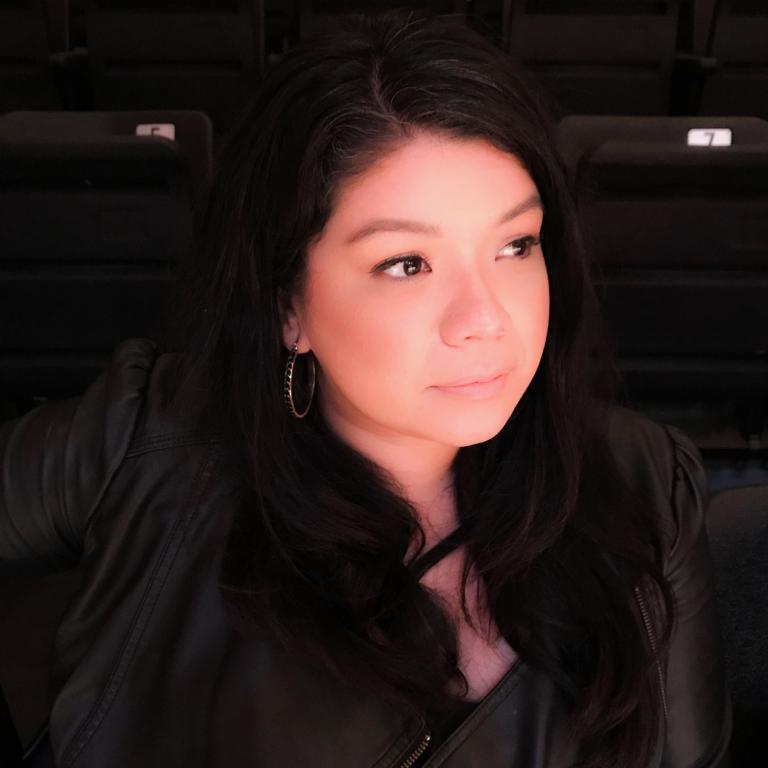
Dr. Daisy Vargas: “The histories of religion and the construction of racial categories were linked to longer processes of colonialism, imperialism, and nation-building”
“My scholarship on race, ethnicity, and religion focused on Latina/o /x religions, has been strongly influenced by my undergraduate training in Chicana/o studies at California State University Fullerton. There, I learned that the histories of religion and the construction of racial categories were linked to longer processes of colonialism, imperialism, and nation-building. Both religious studies and ethnic studies helped me understand different methodologies through which to understand the resilience of diverse communities; religious studies taught me a lived religions approach and ethnic studies taught me the importance of decolonial scholarship.
For me, ethnic studies approaches in religious studies have worked to critique traditional frameworks of historiography and anthropological studies of Chicana/o religion— these critical stances have been important in decentering and disrupting early scholarship from the fields of anthropology and sociology that pathologized religious and cultural practices, like curanderismo, and supported highly racialized ideas like ‘cultures of poverty.’ The process and praxis centered approaches employed by ethnic studies scholars are continuing to push scholarship beyond critique and into scholarship as a decolonial praxis, evoking the first generation of scholar of ethnic studies.
Ethnic studies encourages substantive approaches to examinations of categories of power, race, and citizenship; in religious studies, this intersects with acknowledging the colonial and imperialist legacies of the discipline, and focusing on moving the field towards scholarship that produces research and pedagogy that is reflexive in its methodology. That is, scholarship that reflects the implications of studying racialized communities within larger histories of settler colonialism, slavery, racism, and immigration. An ethnic studies approach to religious studies also challenges and critiques the study of American religion through re-defining the term ‘American’ and questioning the category itself in a way that troubles institutional definitions of citizenship and belonging.”





